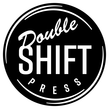We couldn’t be happier to partner with them to print our Double Shift Press titles.
We first started working with Bookmobile back in 2014, when they became a client of ours at Modern Writing Services. Nicole Baxter, Bookmobile’s director of sales, marketing, and publisher services (and all-around excellent person) reached out to inquire about our communications services.
Bookmobile had just gone through a rebranding process and needed help integrating their brand standards with their new website. We provided an extensive edit of the website, along with recommendations and a style guide for their in-house use.
We’ve partnered with them on a number of projects since then, and we always love the work—they’re passionate about what they do, they’re innovative and forward-thinking, and they value good communication. Plus, Nicole has a wicked sense of humor that always makes her emails the highlight of my inbox.
So it was a no-brainer for us to look to Bookmobile for printing and design services when we launched Double Shift Press earlier this year. Bookmobile has worked with over 900 publishers, including luminaries such as Graywolf Press and innovators such as OR Books. If you like to read, chances are you’ve got some of their books on your shelf.
The quality and range of printing and design options that Bookmobile offers far outstrips the print-on-demand services that most self-publishers use. They make everything look stunning, from standard paperbacks and journals to luxe coffee table books and gallery-ready catalogues.





